Appeals Court Upholds Law Barring Protests On Supreme Court Building Property
A Federal Appeals Court has upheld a 1949 law that bars protesters from the property around the Supreme Court building. This seems inconsistent with the Court's recent First Amendment jurisprudence.
A Federal Appeals Court has upheld a law passed in 1949 that bars protesters from the property on which the Supreme Court building is located:
The Supreme Court is designated as the ultimate protector of constitutional rights, but the guarantee of protest and free speech ends on the steps to the plaza in front of the court’s grand marble temple, a unanimous federal appeals court panel ruled Friday.
Demonstrators are allowed on the sidewalk in front of the court but not any closer to the famous portico promising “Equal Justice Under Law,” three judges of the U.S. Court of Appeals for the District of Columbia Circuit decided.
The fight over where protesters get to protest has been going on for years.
The appeals court judges upheld a 1949 law that forbids demonstrations on the grounds of the high court, on the premise that protests at the court’s doorstep might lead to the perception that the justices are swayed by vox populi rather than the dictates of the law.
“Allowing demonstrations directed at the Court, on the Court’s own front terrace, would tend to yield the opposite impression: that of a Court engaged with — and potentially vulnerable to — outside entreaties by the public,”wrote U.S. Circuit Judge Sri Srinivasan, who argued often before the court as a lawyer and is sometimes mentioned as a future Supreme Court justice.
On days when controversial cases are argued and decided, the 50-foot-wide sidewalks surrounding the court are filled with chanting, flag-waving, bullhorn-toting protesters of all stripes. The Supreme Court itself, in 1983, ruled that these sidewalks — on First Street NE, just across from the Capitol — are open for protests.
But demonstrators are not allowed any closer. The court in its 1983 decision did not address the protest restrictions on the court’s grounds, which include the 252-by-98-foot oval marble plaza, with its fountains, benches, flagpoles and steps leading to the court’s iconic, six-ton bronze doors.
Critics have found the no-speech zone around the Supreme Court ironic if not hypocritical. The current court considers itself a fierce protector of political speech, knocking down restrictions on corporate spending on elections, for instance. The justices also struck a Massachusetts law that limited speech around abortion clinics.
In 2010, because of security concerns, the court said the public was no longer allowed to enter through the massive front doors. Visitors must go through security checkpoints on the ground floor, although they may exit via the court’s front porch.
The 1949 federal statute makes it unlawful to “parade, stand, or move in processions or assemblages in the Supreme Court Building or grounds, or to display in the Building and grounds a flag, banner, or device designed or adapted to bring into public notice a party, organization, or movement.”
In 2013, U.S. District Judge Beryl Howell struck down the restrictions. “It cannot possibly be consistent with the First Amendment for the government to so broadly prohibit expression in virtually any form in front of a courthouse, even the Supreme Court,” Howell wrote in a 68-page opinion.
Within days, the Supreme Court instituted its own rules that essentially kept the restrictions in place, and the legal fight has continued.
(…)
Srinivasan said the court is different from Congress, where people have a right to protest for political action. The plaza is designed as an extension of the court, he said, and restrictions on protests there need only be reasonable and viewpoint-neutral.
There is no suggestion that the law is discriminatory, he said: “Demonstrations supporting the court’s decisions and demonstrations opposing them are equally forbidden in the plaza.”
Srinivasan added: “Unless demonstrations are to be freely allowed inside the Supreme Court building itself, a line must be drawn somewhere along the route from the street to the Court’s front entrance. . . . Among the options, it is fully reasonable for that line to be fixed at the point one leaves the concrete public sidewalk and enters the marble steps to the Court’s plaza.”
I first wrote about this issue last October, just after the Appeals Court panel had heard oral argument in this case, which itself is a reflection of just how slowly some cases seem to move through the Federal Court system. As I noted at the time, the fact that the protests that would seem to be clearly protected by the First Amendment are forbidden on the property of the Supreme Court is incredibly ironic given the fact that the Roberts Court has been extremely aggressive at protecting First Amendment rights over the past ten years. During this period, the Court has struck down a civil verdict against the Westboro Baptist Church that had been won by the father of a fallen solider whose funeral the church was protesting. It has also struck down a Federal law that made it a crime for someone to lie about having received military honors, a California law regulating the sale of “violent” video games, a Massachusetts law restricting the space within which protests can take place at abortion clinics, and allowed a lawsuit challenging an Ohio law purporting to punish untruths told in an election campaign to proceed forward. All of these decisions have either been unanimous or nearly so, leading many legal commentators to argue that the Roberts Court has been one of the most aggressive Courts when it comes to protecting First Amendment rights. On the campaign finance side, the Court’s rulings in cases such as Citizens United and McCutecheon v. FEC were both based largely on the First Amendment and the majority’s argument that the right of people to participate in the political process outweighed any others concerns. While those decisions have proven to be more controversial than the others, they lend further to support for the arguments in favor of the Robert’s Court’s reputation as a First Amendment champion. For that reason alone, the ongoing restrictions regarding public protests on Court property are at the very least ironic if not contradictory.
The justifications used the Court of Appeals in upholding this law are utterly absurd. Essentially, Judge Srinivasan, a recent Obama appointee, argues that the 1949 ban is necessary to protect the “dignity” of the Court from the impression that the Justices are can be influenced by public opinion. This argument belies a notion of a non-political Supreme Court that simply doesn’t hold up to reality. While it’s true that Justices, and Judges, are appointed for life terms largely for the purpose of shielding them from political pressure, to deny that politics plays a role in how the Court is composed or the kinds of cases it hears it absurd. Obviously, it would be improper for a Justice to base their opinion in a particular on public opinion rather than on the law and the facts of the case before them. Even taking that into account, though, the legitimate concern about limiting the influence of public opinion on judicial decisions is not a sufficient reason on a blanket ban on speech on the property of the nation’s highest court. To take Judge Srinivasan’s logic at face value, one would have to believe that the Justices of the Supreme Court are so weak-willed that they would influenced by protesters that, given how the building is constructed, they would not even see and probably cannot hear. It’s obvious, though, that it isn’t the risk of improper influence that concerns Judge Srinivasan, but the apparent belief that allowing protests on Court property would somehow taint the image of the Court itself. This is not a sufficient justification for a blanket ban on First Amendment activity, and it cannot withstand scrutiny under the Court’s own First Amendment case law. The fact that Srinivasan is apparently on the short list of potential future Democratic nominees to the Supreme Court just makes his opinion here all the more troublesome.
The Court’s ruling here would seem to be in direct conflict with the Supreme Court’s 2013 ruling in McCullen v. Coakley. In that case, a unanimous Court struck down a Massachusetts law that barred any protests at all within a certain distance from an abortion clinic. In that case, Massachusetts barred protests on the ground that it was necessary to protect patients and clinics from harassment, but the Court ruled that even if that justification were acceptable, a blanket ban on any First Amendment activity on public property would simply impermissible. Using the logic in that case, it is hard to see how a blanket ban on protests on Supreme Court property, which is after all public property could stand. The Court of Appeals’ arguments about protecting Justices from the vicissitudes of public opinion and protecting the image of the Court simply don’t seem like they can stand given that the Justices rejected similar arguments from the Commonwealth of Massachusetts.
None of this is to say that there couldn’t be some regulation of protests on the Court’s property. The Supreme Court has long recognized that, even under the First Amendment, government entities have a right to make reasonable time, place, and manner regulations when it comes to otherwise protected activities such as protests and marches. These restrictions, however, must be content neutral, and it’s generally recognized that blanket bans on protest are impermissible absent a very compelling interest that cannot be achieved by less restrictive means. In this particular case, the Court and the U.S. Marshall’s charged with providing security, could most certainly establish some regulations regarding the size and location of protests in the interests of things such as crowd control or security. For example, a regulation banning protests on the steps of the Supreme Court Building, but allowing it on the plaza, would probably be permissible given the obvious security and public safety issues involved. Similarly, as with any other protest, people who interfere with legitimate security operations, who become disorderly, or refuse to disperse after the agreed-upon end of the protest could be arrested. Beyond those types of legitimate security and safety regulations, though, there appears to me to be no legitimate justification for the blanket ban on protests that has been in place since 1949.
From here, this case can take one of two paths, both of which would ultimately lead to the Supreme Court. The Plaintiff could chose to seek review directly to the Supreme Court, or it could seek a hearing before the entire D.C. Circuit Court of Appeals, after which either party could then seek Supreme Court review. Which ever option is chosen, though, at some point the Justices are going to have to rule on this matter. Back in 1983, the Court dealt with this in United States v. Grace and ended up striking down a ban on protest signs, but only applied to the public sidewalks in front of the Court building. This time, they would be required to deal with the law as a whole and it’s hard to see how they could let it stand and still be consistent with the more than decade of First Amendment law that they established.
Here’s the opinion:
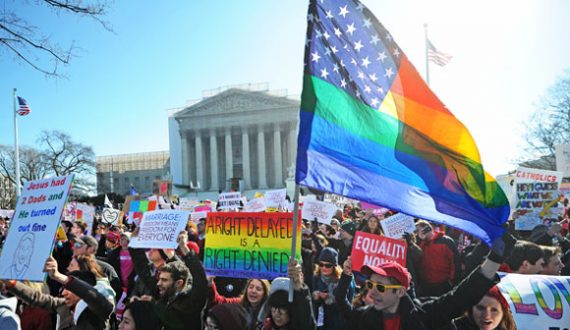

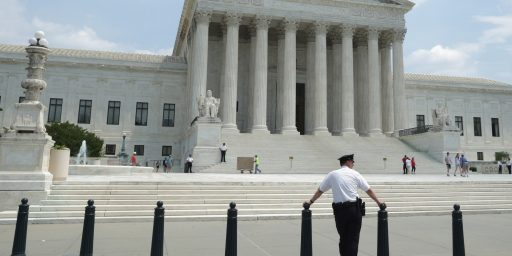
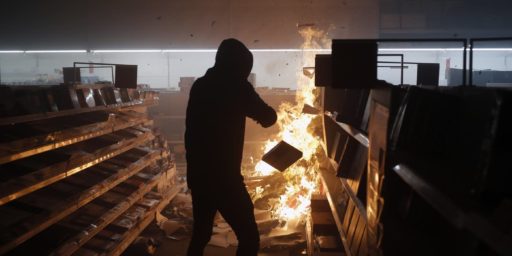
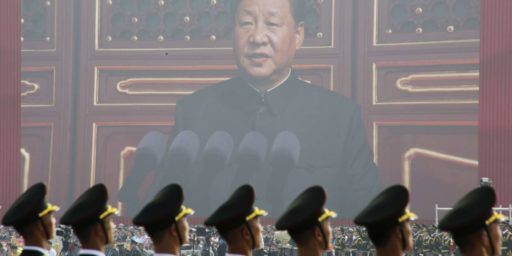
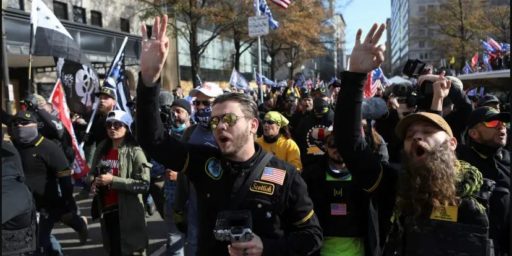
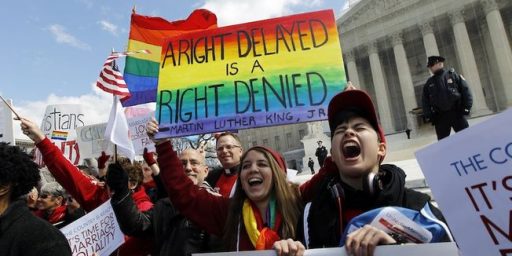
There is no blanket ban on protests at the court, as the crowds of protesters which can be found on the sidewalks in front of the court building when any contentious issue is under review will attest to.
Srinivasan is right – if the plaza, why not the lobby? It the lobby, why not the courtroom itself? A line has to be drawn which respects both the need of the court to conduct business and the desire of the protesters to speak. The current line does both admirably well. I’ll speak from personal experience in saying that the protest bunch is a source of amusement, and occasionally annoyance, for the clerks, but the justices themselves barely notice them, if at all. I certainly never heard any of them make mention of it.
You’re talking about a group of nine people who still send written memos to each other rather than have a conversation. Souter actually wrote them all out in fountain pen, eschewing even a typewriter / word processor. Many of them will regularly go an entire week without directly speaking to their colleagues until conference. Their world is the arguments regarding the appeals which are in front of them and the extent of their sphere of daily interpersonal contact is almost entirely their clerks.
Trust me that they couldn’t care any less about public opinion, even when the public is showing its collective ass outside their door.
Saying “you can only protest on the sidewalk, not the plaza” is NOT the same thing as saying “you may not protest at all”. They’ll let this one stand.
There is a reasonable concern for security and public safety that would justify a ban on protests in the lobby, or even on the steps of the building. I do not believe that argument extends to the entire plaza. Additionally, Srinvasan’s argument that the ban is necessary to protect the dignity of the Court is utterly absurd. The Supreme Court does not exist in a vacuum and it shouldn’t be able to shield itself from the First Amendment in ways that other branches of the Federal Government cannot do.
And I agree with you that, generally, the Justices do not care about the protests. If that’s the case, though, and given that the government was not able to articulate a security-based reason for barring protests in the plaza, then why have the ban on protests in the plaza at all?
I was thinking about this and came up with these questions. Can a lower court tell the Supreme Court what to do ? Can this ruling be appealed to the Supreme Court ? Can the Supreme Court rule on an issue that is its own interest ? It seems like a conundrum, a chicken or egg, whose on first – what’s on second puzzle.
The people will say “not in my backyard”. The Supreme Court says “not in our front yard ! “
@Doug Mataconis:
Because there are a great deal more people conducting business in, and who have to go to and from from, that building besides the nine.
The general problem is that the people engaged (I’d say crazy) enough to show up at the court to protest an issue are generally so passionate about their pet cause that they see no limits to how far they should be allowed to go in pursuing them. The appellee in this case CERTAINLY fits that description. Moving the line does nothing to enhance the ability of the protesters to speak, but it would negatively impact the ability of the court as an agency to conduct business.
The thing I wish these protesters understood is how utterly unconcerned the nine are with these protests. I used to wish the looneys knew and understood the degree to which the justices neither notice nor care about what these people have to say. It might encourage them to find more productive ways to spend their time.
That having been said (I obviously do not like these people, so take that with a grain of salt), the vast majority of them stay behind the line and conduct their silliness peacefully. I see no reason to change something that’s working well for all concerned.
@Tyrell:
Well, since the case in question deals with a law passed by Congress, then this isn’t really a case of a lower court telling the Supreme Court what to do.
Your question does raise an interesting point, though, because shortly after the District Court in this case struck down the 1949 law back in 2013, the Court issued its own regulations that essentially mirror the law, although at the time it was stated that this was done just to maintain the status quo until the legal issues regarding the law are resolved.
Even if the Court does refuse to hear this appeal, Congress could theoretically respond by repealing the 1949 law on its own. If that happened and the President signed it into law then the Court may seek to enforce the regulations on its own and it’s unclear whom protesters would be able to appeal to for a redress of their grievances.
@HarvardLaw92:
Then the answer is to establish reasonable rules regarding time, place, and manner of demonstrations along with establishing a perimeter to allow for those using the court to get their business done. As you know, though, most people who enter the Court’s building now do not do so through the front entrance anyway.
Also, the fact that you may consider the people who come to the Supreme Court to protest, or as we saw at the end of June await the announcement of important decision and celebrate the outcome if appropriate, to be “crazy” is kind of irrelevant for First Amendment purposes.
@Tyrell:
No.
Yes, but they are not required to accept the appeal.
Yes
@Doug Mataconis:
They already have. People may protest on the sidewalk to their heart’s content. They may not protest on the grounds of the court. Seems reasonable enough to me.
It’s worth noting that there is a largely identical regulation in place barring such activity on the grounds of the Capitol building as well.
@HarvardLaw92: “The general problem is that the people engaged (I’d say crazy) enough to show up at the court to protest an issue are generally so passionate about their pet cause that they see no limits to how far they should be allowed to go in pursuing them. The appellee in this case CERTAINLY fits that description. Moving the line does nothing to enhance the ability of the protesters to speak, but it would negatively impact the ability of the court as an agency to conduct business.”
And yet this Court has ruled that people you might call crazy are allowed to show up at medical clinics and harass patients and doctors, even though they’ve shown they see no limits to how far they should be allowed to go in pursuing their cause. So the only question here is why are those who work at the Supreme Court apparently the only American citizens whose convenience is placed above the FA rights of protestors?
@HarvardLaw92:
I don’t agree that limiting the protesters to the public sidewalk is anywhere close to being the less restrictive means by which those in charge of security at the court could satisfy the legitimate interests that might exist in controlling public access to the grounds.
Additionally, as I said, I don’t see how one can reconcile the Court’s opinion in the abortion clinic case, which I believe was correctly decided, with this policy.
@wr: This, +1,000. The fact that this ridiculous decision about all of us benefit from being engaged in some impromptu “sidewalk counselling” by a random ranting lunatic was unanimous indicates that even the liberals on the court have no discernible connection to reality.
@Doug Mataconis:
You’re free to argue the case to them then. As I said, I generally do not like these protester people, so I’m not troubled by anything that troubles them.
We also disagree on the Massachusetts case. Harassment isn’t protected speech, and make no mistake about it – what those anti-abortion people engage in is harassment.
@HarvardLaw92:
And that, I would submit, is the root of the problem with your analysis here.
@HarvardLaw92:
Except that the Massachusetts law didn’t even try to bar only harassing speech, it barred all speech within a certain area, including speech that would clearly be protected by the First Amendment. I think the fact that even abortion rights stalwarts like Ruth Bader Ginsburg were in the majority in that opinion should be a good example of just how over the top that law was, and why that case was a free speech case and not, as the media portrayed it, an abortion case.
@humanoid.panda: Well, considering that you’re talking about people who can travel from place to place in the Capitol without ever actually stepping onto a public sidewalk, how much connection to reality–discernible or otherwise–are you expecting?
@Tyrell: Not sure you got so many downvotes. Although the answers are somewhat clear (as HL92 provided them), I agree that it’s an interesting dilemma should it be appealed to SCOTUS. Sort of like Congress voting on their own pay raises.
@Doug Mataconis:
The root problem is that
1) I don’t care enough about these imagined 1A implications, and;
2) The nine won’t either. Assuming there is an appeal, and assuming they grant cert, which is questionable IMO, they’ll issue a narrow ruling centered on the fact that the ban in place concerns only the grounds of the court facility itself, not some arbitrary “so many feet away” zone, and ample provision is afforded for the exercise of speech as protesters desire to express it.
The bottom line is that there is no appreciable burden placed on the either the protesters ability to speak or on their ability to be seen by their desired audience. What one can say from the plaza, one can say from the sidewalk, with no – absolutely no – difference with regard to whether or not one’s desired audience can hear or see it. They are allowed to protest, close enough that what they have to express is in full view of the court they wish to address, and the security / logistical interests of the court as an agency are not burdened by their presence.
I realize that civil libertarian types see a boogeyman in any restriction, however small, on a delineated right. I’m just not impressed by this one.
@HarvardLaw92:
If I’m understanding you, you disagree with the MA case which leaves you consistent at least. The court disagreed with you on the MA case, but will likely agree with you on this one in the unlikely event that they even grant cert. That leaves them rather inconsistent on this point. From the outside it certainly looks like free speech that doesn’t effect them or theirs is paramountt, while free speech that effects them or theirs needs more consideration.
@HarvardLaw92:
It is that sort of sneering condescension that puts off a lot of people that otherwise agree with a fair bit of what you have to say. If you toned that down a bit you’d be a fair bit more persuasive, assuming you are communicating to persuade or inform.